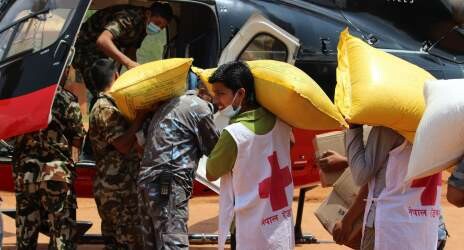
A disaster of this magnitude can be overwhelming for any country to cope with, at any stage of development, and it will be long road to recovery for the people and Government of Nepal. Over the years there has been sustained investment into local preparedness, institution building and planning in the country.
While their new Disaster Management Act is still pending, there have been several developments in Nepal with regard to disaster risk management in recent years. These include the creation in 2009 of the Nepal Risk Reduction Consortium, which brings together humanitarian and development agencies with financial institutions and the government of Nepal. Also in 2009, the government adopted a National Strategy for Disaster Risk Management, which outlines the roles of different ministries during an emergency and established an National Emergency Operations Centre in 2010. All of these mechanisms and frameworks are being operationalised in the current relief and recovery operations. The true test of their success will however be in the months and years ahead.
Nepal Red Cross in partnership with the International Federation of Red Cross and Red Crescent Societies has been supporting government to look into key disaster law issues and to explore ways to strengthen domestic arrangements in the country for many years. Three comprehensive studies have been undertaken in the Nepal looking at legal preparedness for international disaster response operations; disaster risk reduction and the law and also regulatory barriers to transitional and emergency shelter. As the government and people of Nepal, start the long road to recovery ,we will continue to work alongside them to ensure that key recommendations from these reports are taking into account future proof the system, and to make sure that the we build back better and safer.
This report analyses Nepal's legal and policy framework for disaster response, with a focus on large-scale emergencies that exceed national coping capacities, in the light of key international standards. It suggests how those laws and policies should incorporate the recommendations of the IDRL Guidelines.
The numbers of people affected from the earthquake, the widespread damage to infrastructure and building and the web of land ownership and usage rights will create a complexity that has never been experienced in Nepal before. The IFRC shelter response in country is premised on the principle that in all phases of disaster response the right to adequate housing should be respected and protected. The right to adequate housing is much more than a shelter commodity, it is the right to live somewhere in security, peace and dignity.
Analysis of legislation related to disaster risk reduction in Nepal 2011
Nepal was one of the first countries to take forward an analyses on how legislation can support (or impede) disaster risk reduction, particularly at the community level. It examine legislative developments around disaster risk reduction in the country at central and local levels, outlining good practices and identifying the main legal gaps.